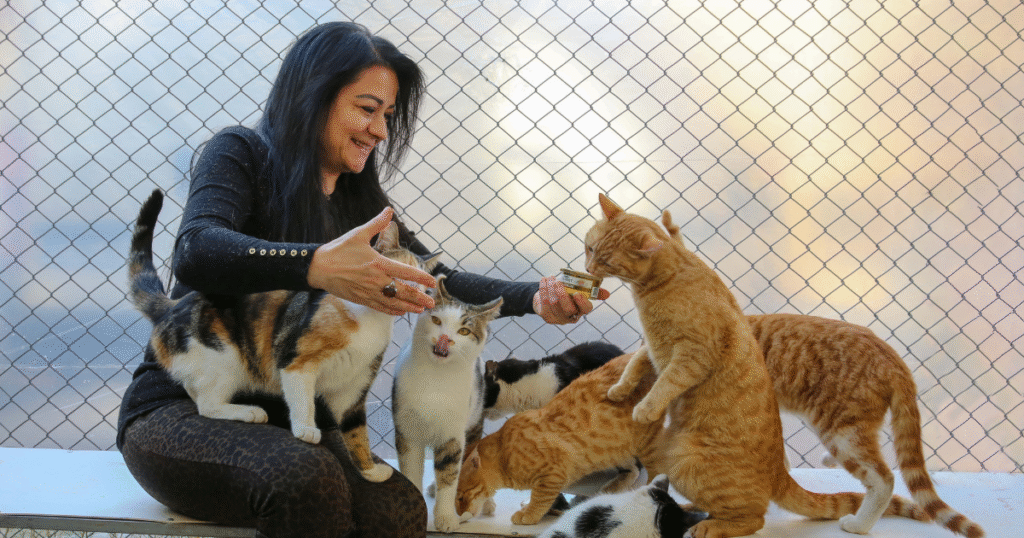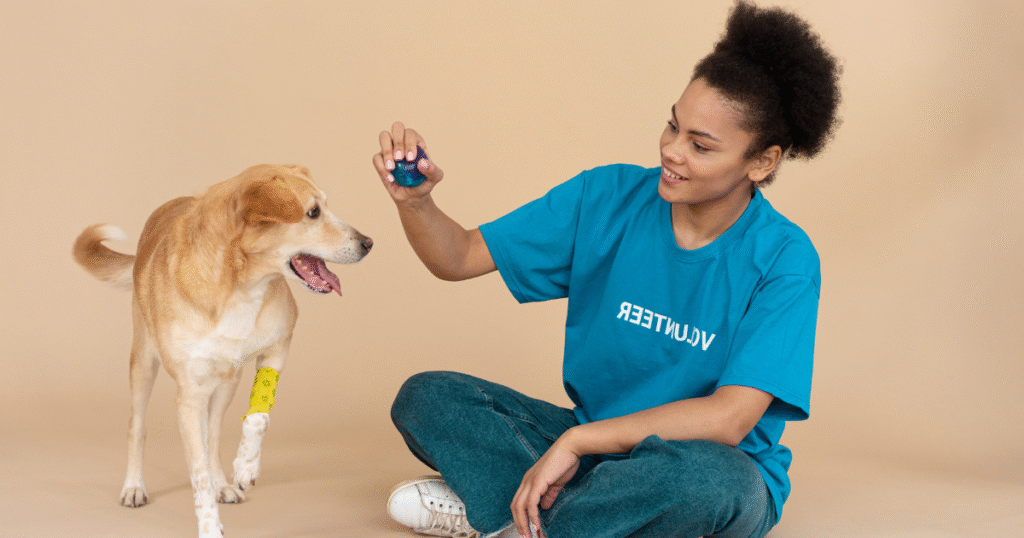Introduction
Caring for a pet stands as a transformative gain that life offers its enthusiasts. Pet Care Tips extends beyond providing nourishment and accommodation since you assume responsibility for their safety and emotional health. As an owner, your pet completely depends on you to maintain its physical state as well as protect its emotional state while ensuring its safety. Every pet parent needs to study and put into practice optimal pet-caring methods from their initial days of ownership. This article presents a complete guide featuring ten necessary pieces of information for those who care for pets. The essential tips for pet health require both mindful scheduling of daily care and knowledge of signals, along with consistent affection towards the pet. By following these guidelines, you will strengthen your relationship with your pet and preserve its long and happy lifespan.
Table of Contents
1. Provide a Balanced and Nutritious Diet
The primary guideline for pet care involves choosing a nutritious and properly balanced diet for your pet. The nutritional state of your pet serves as the base for their complete health condition. Carolina’s wellness depends on their vitality levels while their coat stays smooth together with their immunity functions as their body weight remains balanced and their actions stay normal. The dietary needs of dogs and cats differ completely from each other, along with factors like their age and size, and breed shape requirements. The dietary requirements for puppies and kittens surpass those of adult and senior pet animals. The suitable high-quality pet food products support your pet’s stage-specific nutritional requirements because they were specifically designed to meet such needs.

The consumption of table scraps and processed human food by pets will result in stomach problems along with possible long-term health complications. Human foods, including chocolate, grapes, onions or caffeine, present risks of toxicity to animals that are nontoxic to human bodies. Fresh drinking water at all times alongside controlled portions should be provided to animals because the expanding obesity problem in pets shortens their expected lifespan and can lead to health complications.
2. Schedule Regular Vet Checkups
Professional veterinarians alone have the expertise to uncover hidden internal sicknesses and preliminary illness indicators that cannot be detected by your eyes alone. The most essential advice regarding pet care includes organizing routine veterinarian appointments that occur at least annually or perhaps more often for senior pets. When you visit the veterinarian, your pet will receive a complete physical examination together with weight measurement and monitoring of heart rate dental health assessment, and potentially blood tests to verify organ functions.
The prevention of dangerous diseases such as rabies along with distemper par,vovirus, and feline leukemia is done through vital vaccinations which veterinarians provide during routine appointments. The vet will provide you with information about flea, tick and worm protection that many pet owners neglect until problems emerge. Your pet will experience improved treatment outcomes and an improved lifespan because early detection of health problems enables both cost reductions and better recovery possibilities. A daily pet care routine needs to include regular health checks and documentation of behavior and appetite variations, which should be recorded between veterinary appointments.
3. Keep a Consistent Daily Pet Care Routine
Pets achieve maximum comfort through systematic routines that they find reliable. Regular daily care of your pet helps manage many health processes, including eating and sleeping patterns and behavioral functions. Adopting regular feeding times and regular walks with dedicated pet bonding sessions forms an essential part of pet care. Routine care creates trust between owners and pets while it lessens feelings of nervousness for animals who have experienced trauma or come from shelter situations.
Dogs need consistent bathroom breaks as well as exercise periods during specific daily times. Cats prefer to play in the morning and evening times because these periods match their energetic state. The timing of meals needs to remain steady because inconsistent feedings lead to stomach disturbances and behavioral problems, including excessive begging and aggressive behavior. Routines make it easy for you to detect behavioral changes in your pet since you will be able to notice when your playful cat becomes withdrawn or when your dog skips its meals. All essential pet care advice depends on building this routine, which directly supports their overall wellness.
4. Groom Your Pet Regularly
Getting your pet groomed offers physical comfort as well as health benefits beyond cosmetic purposes. Regular brushing eliminates all foreign substances, together with damaged hair and old skin particles. Through pet grooming, you will get better blood circulation and a stronger emotional connection with your pet. The frequency of pet grooming depends on what breed your pet belongs to. Daily brushing is essential for long-haired pets, and weekly brushing suits short-haired companion animals.
The practice of bathing your pet is essential, but you should avoid going to baths often. Repeated bathing sessions eliminate necessary oils from your skin that lead to dryness. Pets require animal-formulated shampoos for bathing, which should always be followed by complete drying during cold seasons. Regular nail trimming for your pet remains essential because long nails both cause pain and create a significant risk of harm. Regular cleansing of ears and eyes matters because infections can happen when these areas remain unclean. The practice of grooming your pet provides a chance to protect your pet from pain and illness while you inspect for early signs of any lumps or wounds and bumps. The decision to care for your pet requires grooming to be an integral component of your plan.
5. Make Time for Exercise and Mental Stimulation
The physical and mental well-being of your pet depends on exercise. A shortage of daily exercise turns pets, particularly dogs, into restless and anxious creatures who act out destructively. Cats do not require walking, yet they require mental stimulation through interactive play sessions, climbing structures, and physical activity through toys to remain agile and entertained. Pet dogs require walking and running alongside fetch games and puzzle toys to reduce their energy levels while maintaining their optimal weight.

A companion pet needs the same level of mental activity for their well-being. Training your pet’s novel behaviors together with playing hide-and-seek or using new interactive toys allows you to maintain their mental alertness. Regular physical exercise, together with mental workouts, protect animals from developing behavioral issues, which include inappropriate barking and aggression. Pet owners often fail to recognize the significance of exercise in pet care despite urban environments where pets face restricted movement. The combination of physical exercise produces an obedient and emotionally steady pet.
6. Train and Socialize Your Pet from an Early Age
The process of teaching commands involves solving two problems: it trains pets to behave properly in indoor and outdoor environments. Early pet training produces two benefits: it stops behavioral problems, and it develops both bonding and trust with your pet. Your training success will grow through using positive reinforcement tools that combine treats with praise while maintaining consistent behaviors. Harshest forms of punishment should be avoided at all times because they break trust bonds while triggering fear responses leading to aggression.
Training requires socialization to form an essential component. Scientific studies show that animals that meet diverse elements during childhood develop into steadier and calmer adults. Such training minimizes the likelihood of fearful reactions that include biting or hiding. Socialization requires a sustained investment, which forms the basis of your pet’s behavioral nature as it develops. Puppy jumpers need this process alongside home-introduced kittens. Having a trained and socialized pet stands as the most essential pet care guidance since it produces content and obedient animals that make everyone happy.
7. Provide a Safe and Comfortable Living Space
Your house needs to serve as a protective space for your pet. Every environment where pets reside must be secured along with being clean and suitable for their kind. Indoor areas must remain free from potential choking risks that include small toys together with electrical cords in addition to poisonous plants. míceles store cleaning products as well as medicines and foods that could endanger your pet. Your outdoor yard needs proper fencing that does not have sharp edges or unsafe escape possibilities.
A designated resting area providing security is among the essential elements for pets to unwind in comfort. Dogs usually enjoy crates and beds in quiet spaces along with preferred high perches and enclosed cozy areas, which cats prefer. Pet owners must never place their pets in excessive unsupervised periods unless the pets receive food, water, and access to bathroom facilities. Ans and comfort emerge through correct pet care practices, which demand a proper setup and preparation of the environment.
8. Pay Attention to Dental Health
Dental health ranks as one of the least priority aspects among pet care tips, even though it merits considerable attention. The accumulation of plaque and tartar will cause gum disease, which leads to tooth loss and infectious conditions that spread throughout vital organs, reaching areas such as the heart and kidneys. Using pet-specific toothpaste regularly during dental brushing helps stop these issues from developing. Pet-approved chewing toys, together with dental chews and treats, serve as excellent tools for pet oral hygiene.
Your pet needs dental attention if you notice signs such as bad breath because it hints at dental problems alongside difficulties chewing and increased drooling along with swollen gums. Dental disease becomes severe when unattended, which causes severe trauma and Poor health outcomes for your pet. Organizing dental treatment with other pet care duties will help your pet maintain a healthy state with no pain.
9. Watch for Changes in Behavior or Routine
Pets communicate through behavior. Your pet exhibits unusual behaviors that typically indicate that something unhealthy is affecting its health. Use the litter box dilemma of an altered kitty or the behavioral shift of an inactive dog package as symptoms that your pet might be sick or feel pain or stress. All variations in appetite, together with changes in sleep patterns and energy levels, require immediate attention from your veterinarian.

Inspect any minor behavioral alterations and contact a veterinarian immediately when noticing any abnormal behaviors. When pets show behavioral problems, they might need more activities to stay stimulated since their behavior can become bad because of boredom. Providing more engagement usually helps them avoid destructive behavior. Pet care tip number one for serious issue prevention lists close observation as the most important step.
10. Offer Unconditional Love and Affection
Your pets need the most important thing from you, which is your love combined with your attention to them. Psychological well-being flourishes in their lives because they experience deep emotional connection with their owners. Devote your time to holding your pet and having conversations while maintaining your presence. Every pet has its preferences for physical connection, but all of them seek the emotional bond of being with their owner. Showing love to your pet enables you to create a bond that benefits their happiness and deepens your emotional state.
Making daily pet care include affectionate time, and interaction helps your pet feel secure and loved. The importance of providing emotional support equals the significance of physical attention in pet care. Such feelings create the transformative aspects that elevate pet ownership to its rewarding benefits.
Conclusion
The path of being a pet guardian consists of enduring lifelong experiences that include happiness together with hurdles alongside personal development. Using these top 10 pet care guidelines, you can give your furry companion every aspect needed to reach physical as well as emotional and social well-being. Following healthy food and vet care combined with loving and exercising your pet leads you toward becoming the ultimate pet guardian you aspire to be. A dedicated pet owner should begin their pet care education process by implementing these basic and effective practices as daily habits. Caring for your pet to achieve their physical and emotional well-being delivers the most fulfilling reward.

Pingback: How to Choose the Right Pet for Your Family In 12 Steps? - thepfinfo.com